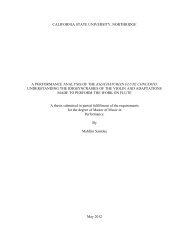Page 1 The California ""- Geographer Annual Publication of the ...
Page 1 The California ""- Geographer Annual Publication of the ...
Page 1 The California ""- Geographer Annual Publication of the ...
Create successful ePaper yourself
Turn your PDF publications into a flip-book with our unique Google optimized e-Paper software.
It was also discovered that <strong>the</strong> boundaries <strong>of</strong> <strong>the</strong>se Dsbm' and Csbm' areas<br />
closely correspond to <strong>the</strong> 90-inch mean isohyet (Figure 2).<br />
<strong>The</strong> "m'' area was broken into two classifications, Dsbm' and Csbm',<br />
because at about <strong>the</strong> 4,000 to 4,500 foot level in <strong>the</strong> nor<strong>the</strong>rnmost <strong>of</strong> <strong>the</strong><br />
two "m" areas <strong>the</strong>re is a change apparent in <strong>the</strong> vegetation cover. Even<br />
though <strong>the</strong> precipitation is extremely high in <strong>the</strong>se higher altitudes<br />
(but not as high as it is at elevations below 4,000 feet), and would come<br />
under <strong>the</strong> "m" classification, at least one winter month probably averages<br />
below 32°F. <strong>The</strong>re are no wea<strong>the</strong>r stations in this Dsbm' area, in fact, <strong>the</strong>re<br />
are no year-long inhabitants.<br />
A much smaller region <strong>of</strong> Csbm' climate can be found along <strong>the</strong><br />
Mattole River, sou<strong>the</strong>ast <strong>of</strong> Cape Mendocino, in <strong>the</strong> area around Honeydew.<br />
<strong>The</strong> entire area is probably not more than eight miles in length and less<br />
than five miles in width. Precipitation here is heavy, in fact much heavier<br />
than nearby places such as <strong>the</strong> climatic station fur<strong>the</strong>r downstream at<br />
Upper Mattole. <strong>The</strong> reason for this is due to a funnelling <strong>of</strong> precipitation<br />
into <strong>the</strong> area. A dip in <strong>the</strong> NW /SE trending Coast Range (which is not<br />
more than 4,000 feet in elevation) in <strong>the</strong> area immediately southwest <strong>of</strong><br />
Honeydew is responsible for this. This dip in <strong>the</strong> coastal mountain range<br />
points nor<strong>the</strong>ast from <strong>the</strong> ocean directly toward Honeydew area. <strong>The</strong><br />
extra-tropical cyclones that enter this region normally approach from <strong>the</strong><br />
northwest, west-north-west, and west, but because <strong>of</strong> <strong>the</strong> counterclockwise<br />
circulation <strong>of</strong> winds around low pressure systems in <strong>the</strong> Nor<strong>the</strong>rn Hemisphere<br />
precipitation is carried into this region from <strong>the</strong> south and southwest.<br />
This causes <strong>the</strong> moist air masses to enter directly into <strong>the</strong> dip ,and<br />
this funnelling combined with <strong>the</strong> sharp lifting effect <strong>of</strong> <strong>the</strong> mountains<br />
gives extremely heavy precipitation.<br />
<strong>The</strong> area around Honeydew and that mentioned earlier in Del Norte<br />
County are among <strong>the</strong> wettest in <strong>the</strong> continental United States, exceeded<br />
only by <strong>the</strong> western slope <strong>of</strong> <strong>the</strong> Coast Ranges in Oregon and Washington.<br />
Some extremely high rainfall totals have been recorded in <strong>the</strong> Honeydew<br />
region, where <strong>the</strong>re are two precipitation stations at <strong>the</strong> present time; at<br />
Honeydew (Hunter) and Honeydew 2WSW. For example, in February<br />
1958, Honeydew 2WSW had 58.60 inches <strong>of</strong> precipitation for <strong>the</strong> month<br />
and in December 1955 that same station had a month's total <strong>of</strong> 61.50<br />
July<br />
.14<br />
July<br />
.70<br />
Aug.<br />
.27<br />
Mean Monthly and Seasonal Precipitation (in' inches)<br />
Honeydew 2WSW, <strong>California</strong> (elev., 400')<br />
(based on <strong>the</strong> 50-year period 1904-05 to 1954-55)<br />
Sept. Oct. Nov.<br />
1.38 6.88 15.03<br />
Dec. Jan. Feb. 1\IIar. Apr. l\IIay June<br />
19.77 21.33 17.04 12.87 7.39 3.84 1.54<br />
Monthly Precipitation Totals at Honeydew 2WSW for <strong>the</strong> 1957-58<br />
Precipitation Season<br />
Aug. Sept. Oct. Nov. Dec. Jan. Feb. 1\IIar. Apr. lVIay June<br />
0 8.50 14.65 9.10 20.20 29.10 58.60 19.65 11.15 .95 1.80<br />
Table 3<br />
6<br />
Season<br />
107.48<br />
Season<br />
174.40













